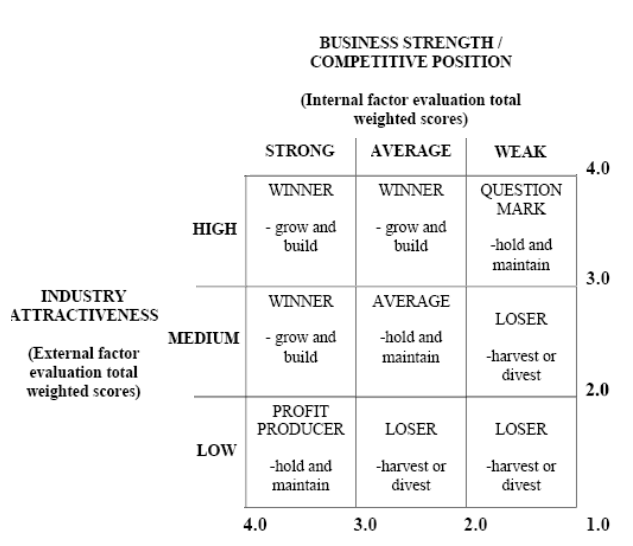The Internal-External (IE) Matrix positions an organization’s various divisions in a nine cell matrix. The IE Matrix is a strategic management tool which is used to analyze the current position of the divisions and suggest the strategies for the future.
The Internal-External (IE) Matrix is based on an analysis of internal and external business factors which are combined into one suggestive model. The IE matrix is a continuation of the EFE matrix and IFE matrix models.
The Internal-External (IE) Matrix is based on two key dimensions: the IFE total weighted scores on the x €‘axis and the EFE total weighted scores on the y axis. Recall that each division of an organization should construct an IFE Matrix and an EFE Matrix for its part of the organization. The total weighted scores derived from the divisions allow construction of the corporate-level IE Matrix. On the x €‘axis of the IE Matrix, an IFE total weighted score of 1.0 to 1.99 represents a weak internal position; a score of 2.0 to 2.99 is considered average; and a score of 3.0 to 4.0 is strong. Similarly, on the y axis, an EFE total weighted score of 1.0 to 1.99 is considered low; a score of 2.0 to 2.99 is medium; and a score of 3.0 to 4.0 is high.
The Internal-External (IE) Matrix can be divided into three major regions that have different strategy implications. First, the prescription for divisions that fall into cells I, II, or IV can be described as grow and build. Intensive (market penetration, market development, and product development) or integrative (backward integration, forward integration, and horizontal integration) strategies can be most appropriate for these divisions. Second, divisions that fall into cells III, V, or VII can be managed best with hold and maintain strategies; market penetration and product development are two commonly employed strategies for these types of divisions. Third, a common prescription for divisions that fall into cells VI, VIII, or IX is harvest or divest. Successful organizations are able to achieve a portfolio of businesses positioned in or around cell I in the IE Matrix.
The Internal-External (IE) Matrix is similar to the BCG Matrix in that both tools involve plotting organization divisions in a schematic diagram; this is why they are both called portfolio matrices. Also, the size of each circle represents the percentage sales contribution of each division, and pie slices reveal the percentage profit contribution of each division in both the BCG and IE Matrix. But there are some important differences between the BCG Matrix and IE Matrix. First, the axes are different. Also, the IE Matrix requires more information about the divisions than the BCG Matrix. Further, the strategic implications of each matrix are different. For these reasons, strategists in multidivisional firms often develop both the BCG Matrix and the IE Matrix in formulating alternative strategies. A common practice is to develop a BCG Matrix and an IE Matrix for the present and then develop projected matrices to reflect expectations of the future. This before and after analysis forecasts the expected effect of strategic decisions on an organization’s portfolio of divisions.
Related Strategic Management Tools:
- Internal Factor Evaluation (IFE) Matrix
- External Factor Evaluation (EFE) Matrix
- Boston Consulting Group(BCG) Growth-Share Matrix
- The Strategic Position and Action Evaluation Matrix (SPACE)
